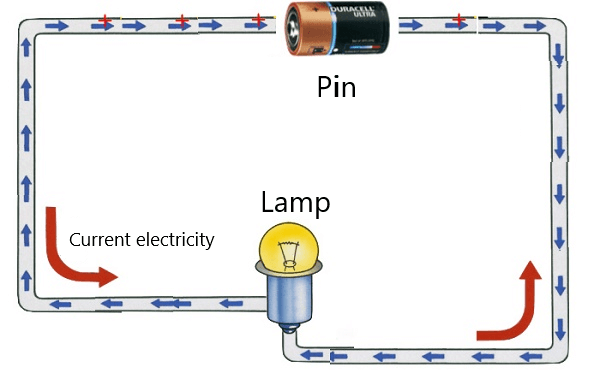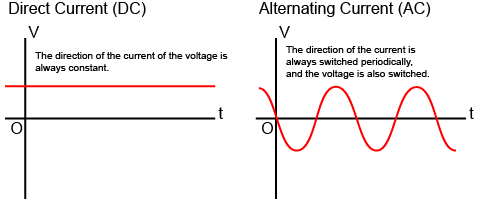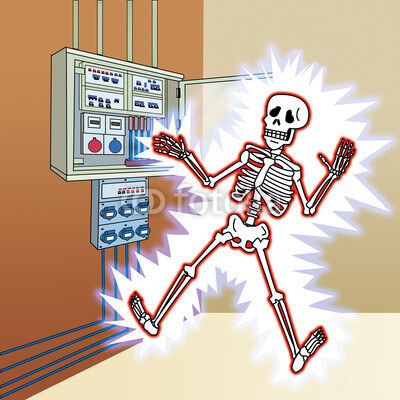What is electrical current? How does current electricity work? Learn about the benefits, harms, and classifications of electric current.
What is electric current?
Electric current is the directional flow of electrons. In metallic materials, the most common conductors are positively charged nuclei that cannot move, only negatively charged electrons can move freely in the conduction band.
Electric current is commonly defined by scientists as the directional displacement of positive charges. Then in an electrical circuit with metal conductors, electrons are charge carriers; the flow of electrons is equal to the magnitude of the current and has the opposite direction of the current in the circuit.

What electric current (Source: imgur)
How does current electricity work?
Assume that we have a copper wire filled with copper atoms. Copper is one of those elements that have only one electron in its outermost shell, meaning that with little energy, that electron can be easily ejected. If we push a free electron into a copper wire, that free electron will push another electron out of the outer shell. This electron will then move on to the next atom, and so on. This sequence of moving electrons creates a flow known as “current.”
However, current doesn’t just magically flow through wires. The electrons in the wire will not be able to move on their own. It needs a little help. We need to give them a little push. To do that, we will use a voltage source like a battery.

How does current electricity work
We talked about the flow of electrons in an electrical circuit. And we showed how electrons move from the cathode to the anode. However we usually specify the current to flow from the anode to the cathode or from a higher voltage to a lower voltage.
Unit of electric current (Ampere)
In the example in the picture above, when we put things like light bulbs in, electricity flows through them, and then they produce light and heat and so on.
To do this, we need to force the electrons to move. And we can do that by applying a voltage to the circuit. Voltage is the thrust. It’s like pressure in a water pipe. The more pressure we have, the more water flows, the more voltage we have, the more electrons can flow.
Just like a pipe is rated to handle a certain amount of water passing through it or a certain pressure. If this level is exceeded, the pipe will burst. Likewise, if too many electrons pass through cables or bulbs, they will explode or burn out. On the contrary, when we reduce the voltage, the electrons move less, so the bulb gets darker.

The magnitude of an electric current flowing through a surface will be defined as the amount of charge passing through that surface in a given unit of time.
We refer to the flow of electrons as current. And we measure this in the unit of Amperes (Amps); This is represented with a capital A. So to measure the amperage in the circuit, we need to use an ammeter. The ammeter will be connected in series with the light bulb so that current flows.
Classification of current
AC and DC are different types of electricity. Many appliances will use a combination of AC and DC.

Difference between DC power and AC power (Source: matsusada)
* Direct Current
Direct current is a current that moves charges in a certain direction and does not change during transmission. Direct current is often abbreviated as DC (Direct Current). DC is usually generated from batteries, solar energy, etc.
We mostly use DC in the circuit boards of small electronic devices, like laptops, mobile phones and televisions. That’s because DC is easier to control and allows circuits to be smaller and more compact.
* Alternating Current
We use AC here because it can be transported very efficiently and over much greater distances than if we were to use DC. We can also very easily increase or decrease the voltage using simple transformers. The symbol is AC in English (meaning Alternating Current).
Alternating Current is an electric current whose direction and magnitude change continuously over time. Normally, the change in current during transmission will be periodic in a sinusoidal profile. Alternating Current are usually generated from AC generators or are converted from DC power.
The benefits and harms of electric current
* Some applications of electric current
+ Alternating current and Direct current are used for many different purposes. The most basic and easy-to-find application is using electricity for lighting.
+ When the current passes through equipment such as light bulbs, irons, dryers, rice cookers, electric stoves, etc., it will heat up. The current flowing through the metal rods causes them to increase in temperature. When overheated, the protective relay inside will automatically cut off the current to pass through it. The temperature is only heated within the manufacturer’s limits.
+ Converting electrical energy into mechanical energy through motors The motor is cheap and easy to use, so it is widely used in industry.
* Harm of electric current
In addition to the benefits of electric current for humans, electric current is dangerous to people if not used properly. Electric current passing through the human body not only affects heat but also affects electrolysis and physiology.
Physiological effects cause irritation, damage to cells, causing muscle twitching. When an electric shock occurs, the current will pass through the heart and cause cardiac arrest. In addition, the electric current also burns blood vessels & nerves.

Electric shock (Source: spiroprojects)
Related Posts
How does electricity work? – Explained Electricity
What is the purpose of a diode – 4 applications of diode
How to reverse three phase motor (5 circuits)
Refer to the video What is current– electricity current explained